You're using an outdated browser. Please upgrade to a modern browser for the best experience.

Submitted Successfully!
Thank you for your contribution! You can also upload a video entry or images related to this topic.
For video creation, please contact our Academic Video Service.
| Version | Summary | Created by | Modification | Content Size | Created at | Operation |
|---|---|---|---|---|---|---|
| 1 | Grzegorz Mentel | -- | 2820 | 2023-02-06 10:46:21 | | | |
| 2 | Jason Zhu | Meta information modification | 2820 | 2023-02-07 03:49:12 | | |
Video Upload Options
We provide professional Academic Video Service to translate complex research into visually appealing presentations. Would you like to try it?
Cite
If you have any further questions, please contact Encyclopedia Editorial Office.
Mentel, G.; Lewandowska, A.; Berniak-Woźny, J.; Tarczyński, W. Green and Renewable Energy Innovations. Encyclopedia. Available online: https://encyclopedia.pub/entry/40870 (accessed on 05 January 2026).
Mentel G, Lewandowska A, Berniak-Woźny J, Tarczyński W. Green and Renewable Energy Innovations. Encyclopedia. Available at: https://encyclopedia.pub/entry/40870. Accessed January 05, 2026.
Mentel, Grzegorz, Anna Lewandowska, Justyna Berniak-Woźny, Waldemar Tarczyński. "Green and Renewable Energy Innovations" Encyclopedia, https://encyclopedia.pub/entry/40870 (accessed January 05, 2026).
Mentel, G., Lewandowska, A., Berniak-Woźny, J., & Tarczyński, W. (2023, February 06). Green and Renewable Energy Innovations. In Encyclopedia. https://encyclopedia.pub/entry/40870
Mentel, Grzegorz, et al. "Green and Renewable Energy Innovations." Encyclopedia. Web. 06 February, 2023.
Copy Citation
Taking into account factors such as unfavorable climate changes, shrinking fossil fuel resources, low energy efficiency, and the pace of population growth, the transformation towards green and renewable energy is one of the most important goals and challenges facing the world. The energy sector is the source of about 75% of global greenhouse gas emissions and energy-related emissions are reaching new record levels. For the energy transition to succeed, innovation at the level of technology, business processes and policies (local, national, and international) are necessary.
green energy
renewable energy
innovation
1. Introduction
Population growth and the accompanying socio-economic development increase the demand for energy and energy-related services, as all societies need such services to meet basic human needs and improve human well-being, and to develop and support production processes [1]. In 2014, the total global consumption of primary energy amounted to approximately 160,310 million MWh, and it was predicted that this value would increase to 240,318 million MWh in 2040 [2]. Global reserves of fossil fuels are depleting very quickly: based on average global usage forecasts, it is assumed that oil and gas may last for 50 more years, and coal and uranium for about 100 more years [3]. Due to the long-term and very intensive use of non-renewable energy sources, there are also harmful effects on the environment, such as air pollution, climate change, and irreversible loss of natural resources.
The UN states that to keep global warming below 1.5 °C, emissions must be reduced by 45% until 2030 and to net zero by 2050 [4]. It is estimated that the energy sector is the source of about three-quarters of global greenhouse gas emissions [5]. Thus, the energy sector plays a fundamental and growing role in achieving the decarbonization of the economy [6]. Therefore, in May 2021, the International Energy Agency (IEA) published its monumental Net Zero by 2050 report, which assumes that the electricity sector must move from being the highest emitting sector in 2020 to the first sector to achieve net zero emissions by 2040 in the world [7]. At the same time, the IEA emphasizes that achieving this goal requires unprecedented efforts by all actors.
Decarbonization of the electricity sector is at the heart of the response to the threat of climate change. Therefore, the Paris Agreement underlines the urgent need for action in this area—in particular, the shift from fossil fuels to renewable energy and increasing energy efficiency [8]. This problem has also been included in the UN Sustainable Development Goals [9]. Goal 7 is to achieve universal access to affordable, reliable, and modern energy and to significantly increase the share of renewable energy in the energy mix. People’s dependence on energy has increased significantly, but energy poverty remains an international development challenge. As energy is a prerequisite for many aspects of modern life, lack of access reflects social and economic inequalities. However, it must be based on low-emission technological solutions that reduce greenhouse gas emissions, and thus improve living and health conditions and ensure sustainable development of life on the planet [9].
However, as the International Renewable Energy Agency (IRENA) highlights in its 2022 Tracking Report on Sustainable Development Goal 7 [10], the latest available data and selected energy scenarios show that at the current pace of progress, the world does not stand much chance of achieving any of the goals and metrics under SDG 7. This is especially true for the most vulnerable groups of countries, which from the beginning have been significantly lagging behind in this area. Worldwide, 91% of the population had access to electricity in 2020, still leaving 733 million people without access to electricity. According to forecasts, the problem of lack of access to electricity in 2030 will still affect 630 million people [11][12].
Renewable energy is defined by the IPCC [13] as:
‘(…) any form of energy from solar, geophysical, or biological sources that is replenished by natural processes at a rate that equals or exceeds its rate of use. Renewable energy is obtained from the continuing or repetitive flows of energy occurring in the natural environment and includes low carbon technologies such as solar energy, hydropower, wind, tide and waves and ocean thermal energy, as well as renewable fuels such as biomass’.
In many cases, the terms renewable energy and green energy are used interchangeably, but there are important differences between the terms. Green energy is a subset of renewable energy and includes resources that provide more environmental benefits as they come from natural sources such as the sun, water, and wind [14].
The International Energy Agency (IEA) proposes the following classification of renewable energy technologies based on their stage of development:
-
First generation technologies, i.e., hydropower, biomass combustion, geothermal energy and heat;
-
Second generation technologies, i.e., solar heating and cooling, wind energy, bioenergy, solar photovoltaics;
-
Third generation technologies, i.e., thermal solar energy, ocean energy, geothermal energy, integrated bioenergy systems [15].
Globally, it is estimated that in 2008 renewable energy accounted for 12.9% of the total 492 exajoules (EJ) of primary energy supply [14]. Moreover, as the WHO report [16] shows, in 2010–2019 the share of renewable energy sources in total final energy consumption increased by only 2.7%. It was a good sign that although the COVID-19 pandemic had a bad effect on the energy transformation and stopped many green energy projects, in 2020 the use of renewable energy sources continued to grow and accounted for over 80% of all new electricity capacity added that year [17]. However, in 2021, the share of renewable energy sources in global electricity production reached only 28.7% (after a slight increase of 0.4%) resulting from the global electricity demand reaching its all-time high, the slowdown in economic activity caused by COVID-19, and drought in several regions that reduced hydropower production [18].
2. Research Trends
As already signaled in the Introduction, innovation is one of the key elements of achieving SDG 7 and accelerating the development of green and renewable energy. Both from the perspective of science and practice, an in-depth understanding of scientific achievements in the field of green and renewable energy is of key importance [19].
The basic criterion for assessing the interest of researchers in a given scientific area and the dynamics of this interest is the number of publications and its distribution over the years [20][21][22][23][24]. Figure 1 shows the number of published documents on green and renewable energy and innovation in 2012–2022. It is worth noting that there is an increasing trend in the number of scientists researching the topic of innovation in the field of green and renewable energy. This increase is particularly noticeable in the last three years, i.e., during the period of intensified discussions on the climate and energy crisis and the green transformation. As the problem of climate change and dwindling fossil resources becomes more urgent, the authors predict that this trend will continue into the future.
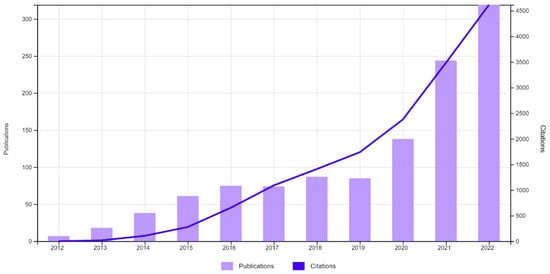
Figure 1. The number of documents on green and renewable energy and innovation and the number of citations of documents (2012–2022).
Table 1 presents the researchers who published at least four papers on green and renewable energy and innovation. The most productive authors in this rating with six articles are Jahid (University of Ottawa, Canada), Anser (Super Univ, Pakistan), and Alsharif (Sejong University, North Korea), followed by Cabeza (University of Lleida, Spain), Ahmad (Shandong University of Technology, China), Dincer (Instanbul Medipol University, Turkey), and Yüksel (Instanbul Medipol University, Turkey) with five papers on green and renewable energy innovation. Meanwhile, twelve authors each published four studies.
Table 1. The leading authors of documents on green and renewable energy and innovation.
| Authors | No. of Papers | % of 1144 | Citations |
|---|---|---|---|
| Jahid, Abu | 6 | 0.5245 | 56 |
| Anser, Muhammad Khalid | 6 | 0.5245 | 32 |
| Alsharif, Mohammed H. | 6 | 0.5245 | 27 |
| Cabeza, Luisa F. | 5 | 0.4371 | 390 |
| Ahmad, Mahmood | 5 | 0.4371 | 20 |
| Dincer, Hasan | 5 | 0.4371 | 11 |
| Yuksel, Serhat | 5 | 0.4371 | 11 |
| Coma, Julia | 4 | 0.3497 | 361 |
| Perez, Gabriel | 4 | 0.3497 | 361 |
| Stucki, Tobias | 4 | 0.3497 | 156 |
| Sarkodie, Samuel Asumadu | 4 | 0.3497 | 121 |
| Asif, Muhammad | 4 | 0.3497 | 119 |
| Kharel, Rupak | 4 | 0.3497 | 109 |
| Zgid, Dominika | 4 | 0.3497 | 106 |
| Kaiwartya, Omprakash | 4 | 0.3497 | 94 |
| Sun, Huaping | 4 | 0.3497 | 42 |
| Olah, Judit | 4 | 0.3497 | 26 |
| Nassani, Abdelmohsen A. | 4 | 0.3497 | 7 |
| Zaman, Khalid | 4 | 0.3497 | 7 |
As Table 2 shows, the most popular journals in the field of green and renewable energy and innovation are Energies (MDPI, IF: 3.252) with 19 publications and 961 citations, Sustainability (MDPI, IF: 3.889) with 91 publications and 650 citations, and IEEE Access (IEEE, IF: 3.476) with 40 published articles and 551 citations. They are followed by the Environmental Science and Pollution Research (Springer Heidelberg, IF: 5.19) with 36 articles and 281 citations and the Frontiers in Environmental Science (Frontiers Media SA, IF: 5.411) with 31 papers and 83 citations.
Table 2. Top 20 journals with articles on green and renewable energy and innovation.
| Journal | No. of Papers | % of 1144 | Citations |
|---|---|---|---|
| Energies | 119 | 10.402 | 961 |
| Sustainability | 91 | 7.955 | 650 |
| IEEE Access | 40 | 3.497 | 551 |
| Environmental Science and Pollution Research | 36 | 3.147 | 281 |
| Frontiers in Environmental Science | 31 | 2.710 | 83 |
| Energy Reports | 26 | 2.273 | 79 |
| Energy Policy | 19 | 1.661 | 739 |
| Economic Research-Ekonomska Istrazivanja | 16 | 1.399 | 80 |
| Frontiers in Energy Research | 16 | 1.399 | 48 |
| Applied Energy | 15 | 1.311 | 845 |
| Applied Sciences-Basel | 11 | 0.962 | 73 |
| IEEE Journal on Selected Areas in Communications | 9 | 0.787 | 444 |
| Renewable Energy | 9 | 0.787 | 305 |
| Journal of Cleaner Production | 9 | 0.787 | 262 |
| Energy Economics | 7 | 0.612 | 290 |
| International Journal of Environmental Research and Public Health | 7 | 0.612 | 47 |
| Renewable and Sustainable Energy Reviews | 6 | 0.524 | 147 |
| Energy Strategy Reviews | 6 | 0.524 | 58 |
| Mathematical Problems in Engineering | 6 | 0.524 | 21 |
| Heliyon | 5 | 0.437 | 27 |
The essential subjects of the research are publications by country, including their social networks [25][26][27]. Table 3 presents the most important countries in accordance with the number of published papers on green and renewable energy innovations. The most productive authors in this area are from the People’s Republic of China with 363 papers (which is 31% of all papers on green and renewable energy innovations). Moreover, important study in this area has been carried out in the USA and England (approximately 10% and 8% of review articles, respectively). Figure 3 shows a geographical map of 93 countries in accordance with the number of published articles.
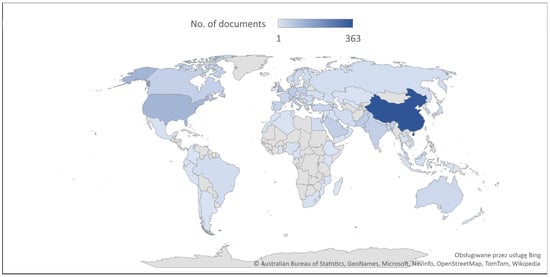
Figure 3. A map of countries in accordance with the number of published articles on green and renewable energy and innovation.
Table 3. Documents on green and renewable energy and innovation by country.
| Country | No. of Papers | % of 1144 | Citations |
|---|---|---|---|
| Peoples Republic of China | 363 | 31.731 | 4182 |
| USA | 118 | 10.315 | 3009 |
| England | 102 | 8.916 | 2619 |
| Italy | 71 | 6.206 | 867 |
| Pakistan | 63 | 5.507 | 814 |
| Germany | 60 | 5.245 | 1607 |
| Poland | 55 | 4.808 | 343 |
| Saudi Arabia | 54 | 4.720 | 970 |
| India | 51 | 4.458 | 525 |
| Canada | 49 | 4.283 | 1197 |
| Spain | 45 | 3.934 | 937 |
| South Korea | 41 | 3.584 | 667 |
| Turkey | 40 | 3.497 | 643 |
| Malaysia | 38 | 3.322 | 425 |
| France | 36 | 3.147 | 603 |
| Taiwan | 33 | 2.885 | 190 |
| Netherlands | 29 | 2.535 | 658 |
| Australia | 28 | 2.448 | 365 |
| Sweden | 27 | 2.360 | 357 |
| Switzerland | 23 | 2.010 | 921 |
The analysis of the organization’s bibliographic links is very interesting due to its complementarity with the results of the citation analysis of authors, institutions, and countries. Figure 4 shows data with a minimum of three documents and 100 institutions meeting the thresholds.
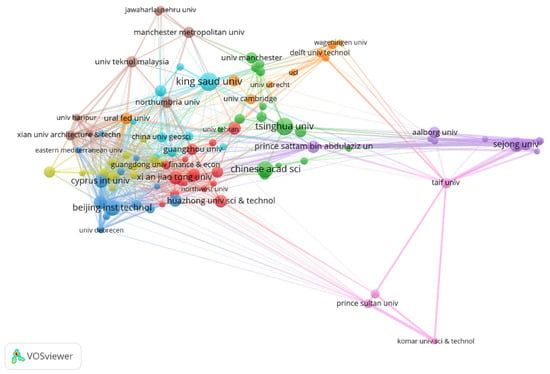
Figure 4. Bibliographic coupling of organizations.
Table 4 presents the most frequently cited articles from the research area under study. It is worth noting that there is a very good representativeness of studies published in the last decade (2012–2022) [28][29][30][31][32][33][34][35][36][37]. This is confirmed by the fact that the topic of innovation in the field of green and renewable energy is a development topic. Moreover, the importance of some studies, such as Richter [35] and Lehr et al. [36], indicate that this topic began to appear in the 2000s, but a particularly dynamic increase in the number of studies in this field could be observed from 2015.
Table 4. Most cited articles.
| Article | Year | Author(s) | Citations | Citations per Year |
|---|---|---|---|---|
| Green preparation of reduced graphene oxide for sensing and energy storage applications | 2014 | Bo et al. | 390 | 48.75 |
| Energy, land-use and greenhouse gas emissions trajectories under a green growth paradigm | 2017 | van Vuuren et al. | 324 | 64.80 |
| Tailoring the energy landscape in quasi-2D halide perovskites enables efficient green-light emission | 2017 | Quan et al. | 316 | 63.2 |
| Energy-efficient base-stations sleep-mode techniques in green cellular networks: A survey | 2015 | Wu et al. | 260 | 37.14 |
| Tubular graphitic-C3N4: A prospective material for energy storage and green photocatalysis | 2013 | Tahir et al. | 207 | 23.00 |
| Renewable energy-driven innovative energy-efficient desalination technologies | 2014 | Ghaffour et al. | 191 | 23.87 |
| Green scheduling of a two-machine flowshop: Trade-off between makespan and energy consumption | 2016 | Mansouri et al. | 175 | 29.16 |
| Business model innovation for sustainable energy: German utilities and renewable energy | 2013 | Richter | 168 | 18.67 |
| Green jobs? Economic impacts of renewable energy in Germany | 2012 | Lehr et al. | 166 | 16.60 |
| Vertical greenery systems for energy savings in buildings: A comparative study between green walls and green facades | 2017 | Coma et al. | 159 | 31.80 |
Based on the co-citations of references analysis, it was possible to define the network of citations. This technique, as reported by Albort-Morant et al. [20] describes the key authors, often cited with other authors. Figure 5 shows a citation map where each circle represents a document, and the size of the circle corresponds to the number of citations [38].
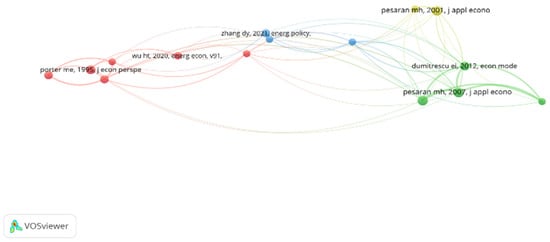
Figure 5. Co-citation of references map.
The analysis defined four clusters of papers that cited each other. The red cluster shows research that mainly concerns the environment–competitiveness relationship [39], renewable energy and technological innovations [40], and energy-saving innovations [41]. The green cluster shows studies that relate to the panel unit root test, as described in [42], and diagnostic tests for cross-sectional relationships in panels, as in [43]. The blue cluster covers the topics of green public finance and sustainable green finance [44], CO2 emissions in the context of economic growth and renewable energy production [45] and energy poverty and energy efficiency [46]. The yellow cluster focuses on research methods [47][48].
In the next step, the technique of bibliographic coupling of authors was employed to identify active researchers in the field and provides a view of the research structure of the front of the field. Of the 4194 authors, researchers selected those with a minimum of three publications and 10 citations. Only 44 authors met the threshold. Figure 6a presents the authors bibliographic coupling map. To make the map more readable researchers created two more showing the four defined clusters more precisely. Figure 6b presents the first three clusters, and Figure 6c presents the fourth cluster, namely:
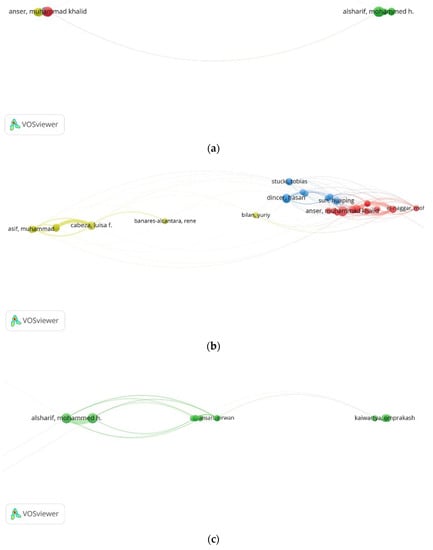
Figure 6. (a) Authors bibliographic coupling map. (b) Authors bibliographic coupling map—clusters 1–3. (c) Authors bibliographic coupling map—cluster 4.
-
The red cluster with 12 authors led by Anser M.K. (Shandong University of Technology, China), Ahmad M. (Super Univ, Pakistan), and Olah J. (University of Johannesburg, South Africa) focuses on financial, technological, and social aspects of green transformation.
-
The blue cluster represented by nine authors, such as Dincer H. (Istanbul Mediapol University, Turkey), Stucki T. (Bern University of Applied Sciences, Switzerland), and Sun H. (Tianjin University of Commerce, China), focuses research on green and renewable energy policy and economics.
-
The yellow cluster covers eight authors including Asif M. (Glasgow Caledonian University, UK), Cabez L.F. (University of Lleida, Spain), and Coma J. (University of Lleida, Spain), whose research focuses on energy aspects of sustainable and green buildings as well as technological aspects of the green transformation.
-
The green cluster includes 11 authors led by Ansharif MA (Sejong University, South Korea), Ansari N. (New Jersey Institute of Technology, US), and Kaiwartya O (Nottingham Trent University, UK), who focus their research on such themes as mobile and cellular networks or sensors for green computing.
Following Phillips et al. [48], in order to illustrate the geographic allocation of knowledge, bibliographic coupling of countries was used. Figure 7 shows three clusters in relation to the network of countries defined as a result of the analysis. The green cluster includes Asian countries under the strong leadership of the People’s Republic of China supported by Latin America (Mexico and Brazil), South Africa, and Canada. Another cluster, red, combines research from the United States and European Union (mostly Italy, Germany, Poland, and France) with contribution from Israel and Egypt. In the blue cluster, the most productive countries are England, Saudi Arabia, Spain, Malaysia, and Australia.
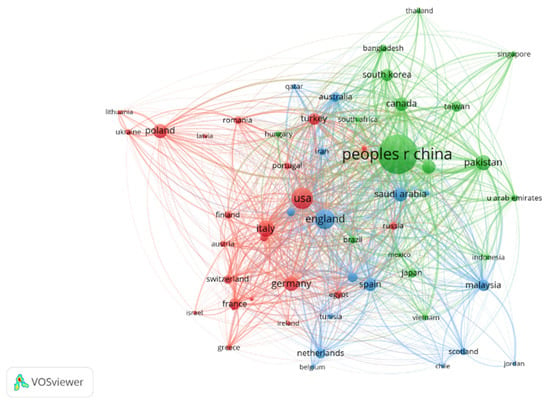
Figure 7. Bibliographic coupling of countries.
The analysis of the author’s keywords is also very important due to the fact that the keywords correspond to the context of the publication and thus define the main topics and research trends [49].
Figure 8 shows the most common author keywords and the author keyword network in articles. The minimum number of author keywords for a co-occurrence map is five and the minimum cluster size is specified as 12. The author’s most popular keywords are renewable energy (131), energy efficiency (90), green energy (57), energy consumption (40), and sustainable development (34). The identified 92 author’s keywords were classified into four clusters.
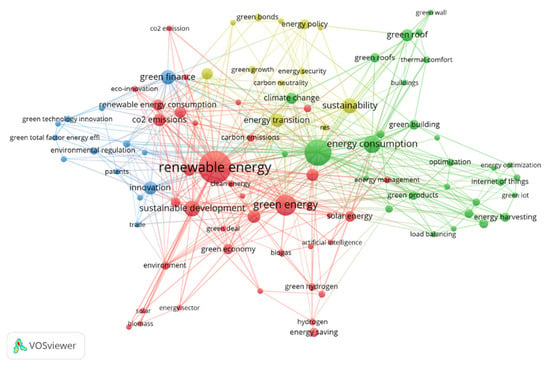
Figure 8. Co-occurrence map (keywords network).
-
The red cluster (38 keywords) encapsulates such terms as renewable energy and green energy followed by sustainable development, CO2 emissions, solar energy, green economy, environmental sustainability, green innovation, renewable energy sources, and technological innovation, which led to the naming of this cluster as “renewable technology innovations”.
-
The green cluster (29 keywords) revolves around the terms energy efficiency and energy consumption, followed by the green roof, green products, climate change, green building, energy harvesting, smart grid, green communication, and optimization, which led to the naming of this cluster as “energy consumption efficiency and sustainability”.
-
The blue cluster (13 keywords) revolves around the terms green finance, innovation, and environmental regulation, followed by patents, green technology innovation, financial development, energy intensity, and environmental policy, which led to the naming of this cluster as “renewable energy innovations ecosystem”.
-
The yellow cluster (12 keywords) revolves around the terms sustainability, energy transition, and economic growth, followed by energy policy, green bonds, green growth, energy security, and carbon neutrality, which led to the naming of this cluster as “renewable energy innovation investments”.
Using the same map, Figure 9 shows the chronological evolution of research topics. Thanks to this, it is possible to identify the most current topics in the researched area, which turn out to be green finance, green innovations, renewable energy consumption, CO2 emission, and carbon neutrality, while energy efficiency related to green construction or energy harvesting have been the main topics of interest in the previous decade.
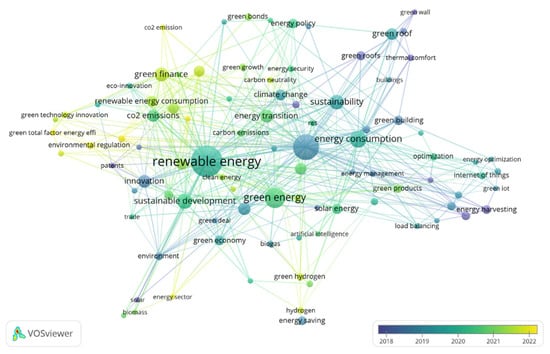
Figure 9. Co-occurrence map (overlay visualization).
Figure 10 presents the most cited journals. The best three journals in the researched area are Energies, Sustainability, and IEEE Access. These journals appear as the most important sources in green and renewable energy research (in the innovation context) and can be helpful for further research and also to the identification of consistent journals on green energy and renewable energy.
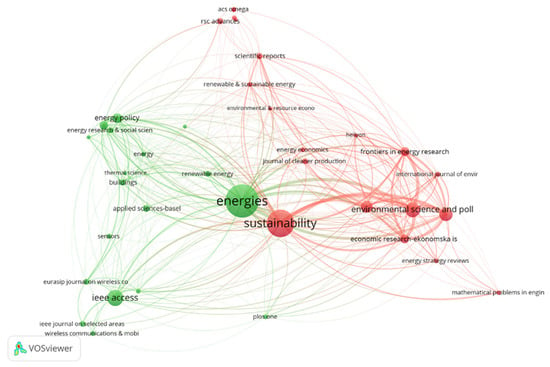
Figure 10. Bibliometric coupling of sources.
References
- Bernai, R.R. Renewable Energy Sources and Climate Change Mitigation, Special Report of the Intergovernmental Panel on Climate Change (IPCC). Econ. Energy Environ. Policy 2013, 2, 101–112.
- Bilgili, M.; Ozbek, A.; Sahin, B.; Kahraman, A. An overview of renewable electric power capacity and progress in new technologies in the world. Renew. Sustain. Energy Rev. 2015, 49, 323–334.
- Kiciński, J. Green energy transformation in Poland. Bulletin of the Polish Academy of Sciences. Tech. Sci. 2021, 69, e136213.
- Ogunbode, C.A.; Doran, R.; Böhm, G. Exposure to the IPCC special report on 1.5 C global warming is linked to perceived threat and increased concern about climate change. Clim. Chang. 2020, 158, 361–375.
- Ritchie, H.; Roser, M.; Rosado, P. CO₂ and Greenhouse Gas Emissions, Published Online at OurWorldInData.org. 2020. Available online: https://ourworldindata.org/co2-and-other-greenhouse-gas-emissions (accessed on 1 December 2022).
- Barresi, G.; Marisca, C. Energy policy and environmental sustainability in regional development strategy: The regional environmental energy plan in Sicily (PEARS). In Moving from the Crisis to Sustainability: Emerging Issues in the International Context; Calabro, G., D’Amico, A., Lafranchi, M., Moschella, G., Pulejo, L., Salomone, R., Eds.; Franco Angeli Editore: Milano, Italy, 2011; pp. 209–218. ISBN 9788856847055.
- Bouckaert, S.; Pales, A.F.; McGlade, C.; Remme, U.; Wanner, B.; Varro, L.; D’Ambrosio, D.; Spencer, T. Net Zero by 2050: A Roadmap for the Global Energy Sector. 2021. Available online: https://trid.trb.org/view/1856381 (accessed on 1 December 2022).
- Delbeke, J.; Runge-Metzger, A.; Slingenberg, Y.; Werksman, J. The Paris agreement. In Towards a Climate-Neutral Europe; Routledge: London, UK, 2019; pp. 24–45.
- United Nations General Assembly: Transforming Our World: The 2030 Agenda for Sustainable Development: Draft Resolution Referred to the United Nations Summit for the Adoption of the Post-2015 Development Agenda by the General Assembly at Its 69th Session. UN Doc. A/70/L.1 of 18 September 2015. Available online: https://digitallibrary.un.org/record/803352 (accessed on 1 December 2022).
- IRENA, Tracking SDG 7: The Energy Progress Report, Publ.-SDG-7-2021. 2021. Available online: https://www.irena.org/publications/2021/Jun/Tracking-SDG-7-2021 (accessed on 1 December 2022).
- Salman, M.; Zha, D.; Wang, G. Assessment of energy poverty convergence: A global analysis. Energy 2022, 255, 124579.
- Piwowar, A. Energy Poverty as a Current Problem in the Light of Economic and Social Challenges. Energies 2022, 15, 8554.
- Change, IPCC Climate. Mitigation of climate change. Contrib. Work. Group III Fifth Assess. Rep. Intergov. Panel Clim. Chang. 2014, 1454, 147.
- Perathoner, S.; Centi, G. New Energy Sources and CO2 Treatment. Glob. Chang. Energy Issues Regul. Policies 2013, 2, 143–160.
- International Energy Agency. World Energy Outlook; OECD/IEA: Paris, France, 2009; p. 17.
- World Health Organization, Tracking SDG 7: The Energy Progress Report 2022. Available online: https://trackingsdg7.esmap.org/ (accessed on 1 December 2022).
- Zhongming, Z.; Linong, L.; Xiaona, Y.; Wangqiang, Z.; Wei, L. World Adds Record New Renewable Energy Capacity in 2020. 2021. Available online: http://resp.llas.ac.cn/C666/handle/2XK7JSWQ/321399 (accessed on 1 December 2022).
- Zhongming, Z.; Linong, L.; Xiaona, Y.; Wangqiang, Z.; Wei, L. Global Energy Review. 2021. Available online: https://www.iea.org/reports/global-energy-review-2021/renewables (accessed on 1 December 2022).
- Page, M.J.; McKenzie, J.E.; Bossuyt, P.M.; Boutron, I.; Hoffmann, T.C.; Mulrow, C.D.; Shamseer, L.; Tetzlaff, J.M.; Akl, E.A.; Brennan, S.E.; et al. The PRISMA 2020 statement: An updated guideline for reporting systematic reviews. Int. J. Surg. 2021, 88, 105906.
- Albort-Morant, G.; Henseler, J.; Leal-Millán, A.; Cepeda-Carrión, G. Mapping the field: A bibliometric analysis of green innovation. Sustainability 2017, 9, 1011.
- Ahmed, S.; Huang, B. Control engineering practice in 25 years: A bibliometric overview. Control Eng. Pract. 2019, 88, 16–20.
- Udomsap, D.; Hallinger, P. A bibliometric review of research on sustainable construction, 1994–2018. J. Clean. Prod. 2020, 254, 120073.
- Hernández-Torrano, D.; Ibrayeva, L. Creativity and education: A bibliometric mapping of the research literature (1975–2019). Think. Ski. Creat. 2020, 35, 100625.
- Xie, H.; Zhang, Y.; Duan, K. Evolutionary overview of urban expansion based on bibliometric analysis in Web of Science from 1990 to 2019. Habitat Int. 2020, 95, 102100.
- Zou, Y.; Luo, Y.; Zhang, J.; Xia, N.; Tan, G.; Huang, C. Bibliometric analysis of oncolytic virus research, 2000 to 2018. Medicine 2019, 98, e16817.
- Veloutsou, C.; Mafe, C.R. Brands as relationship builders in the virtual world: A bibliometric analysis. Electron. Commer. Res. Appl. 2020, 39, 100901.
- Peng, R.Z.; Zhu, C.; Wu, W.P. Visualizing the knowledge domain of intercultural competence research: A bibliometric analysis. Int. J. Intercult. Relat. 2020, 74, 58–68.
- Bo, Z.; Shuai, X.; Mao, S.; Yang, H.; Qian, J.; Chen, J.; Yan, J.; Cen, K. Green preparation of reduced graphene oxide for sensing and energy storage applications. Sci. Rep. 2014, 4, 4684.
- Van Vuuren, D.P.; Stehfest, E.; Gernaat, D.E.; Doelman, J.C.; van den Berg, M.; Harmsen, M.; De Boer, H.S.; Bouwman, L.F.; Daioglou, V.; Edelenbosch, O.Y.; et al. Energy, land-use and greenhouse gas emissions trajectories under a green growth paradigm. Glob. Environ. Chang. 2017, 42, 237–250.
- Na Quan, L.; Zhao, Y.; de Arquer, F.P.G.; Sabatini, R.; Walters, G.; Voznyy, O.; Comin, R.; Li, Y.; Fan, J.Z.; Tan, H.; et al. Tailoring the Energy Landscape in Quasi-2D Halide Perovskites Enables Efficient Green-Light Emission. Nano Lett. 2017, 17, 3701–3709.
- Wu, J.; Zhang, Y.; Zukerman, M.; Yung, E.K.-N. Energy-Efficient Base-Stations Sleep-Mode Techniques in Green Cellular Networks: A Survey. IEEE Commun. Surv. Tutor. 2015, 17, 803–826.
- Tahir, M.; Cao, C.; Butt, F.K.; Idrees, F.; Mahmood, N.; Ali, Z.; Aslam, I.; Tanveer, M.; Rizwan, M.; Mahmood, T. Tubular graphitic-C3N4: A prospective material for energy storage and green photocatalysis. J. Mater. Chem. A 2013, 1, 13949–13955.
- Ghaffour, N.; Lattemann, S.; Missimer, T.; Ng, K.C.; Sinha, S.; Amy, G. Renewable energy-driven innovative energy-efficient desalination technologies. Appl. Energy 2014, 136, 1155–1165.
- Mansouri, S.A.; Aktas, E.; Besikci, U. Green scheduling of a two-machine flowshop: Trade-off between makespan and energy consumption. Eur. J. Oper. Res. 2016, 248, 772–788.
- Richter, M. Business model innovation for sustainable energy: German utilities and renewable energy. Energy Policy 2013, 62, 1226–1237.
- Lehr, U.; Lutz, C.; Edler, D. Green jobs? Economic impacts of renewable energy in Germany. Energy Policy 2012, 47, 358–364.
- Coma, J.; Pérez, G.; de Gracia, A.; Burés, S.; Urrestarazu, M.; Cabeza, L.F. Vertical greenery systems for energy savings in buildings: A comparative study between green walls and green facades. Build. Environ. 2017, 111, 228–237.
- Vošner, H.B.; Kokol, P.; Bobek, S.; Železnik, D.; Završnik, J. A bibliometric retrospective of the Journal Computers in Human Behavior (1991–2015). Comput. Human Behav. 2016, 65, 46–58.
- Porter, M.E.; van der Linde, C. Toward a New Conception of the Environment-Competitiveness Relationship. J. Econ. Perspect. 1995, 9, 97–118.
- Johnstone, N.; Haščič, I.; Popp, D. Renewable Energy Policies and Technological Innovation: Evidence Based on Patent Counts. Environ. Resour. Econ. 2010, 45, 133–155.
- Popp, D. Induced Innovation and Energy Prices. Am. Econ. Rev. 2002, 92, 160–180.
- Pesaran, M.H. A simple panel unit root test in the presence of cross-section dependence. J. Appl. Econ. 2007, 22, 265–312.
- Pesaran, M.H. General diagnostic tests for cross-sectional dependence in panels. Empir. Econ. 2021, 60, 13–50.
- Zhang, D.; Mohsin, M.; Rasheed, A.K.; Chang, Y.; Taghizadeh-Hesary, F. Public spending and green economic growth in BRI region: Mediating role of green finance. Energy Policy 2021, 153, 112256.
- Charfeddine, L.; Kahia, M. Impact of renewable energy consumption and financial development on CO2 emissions and economic growth in the MENA region: A panel vector autoregressive (PVAR) analysis. Renew. Energy 2019, 139, 198–213.
- Li, W.; Chien, F.; Hsu, C.-C.; Zhang, Y.; Nawaz, M.A.; Iqbal, S.; Mohsin, M. Nexus between energy poverty and energy efficiency: Estimating the long-run dynamics. Resour. Policy 2021, 72, 102063.
- Pesaran, M.H.; Shin, Y.; Smith, R.J. Bounds testing approaches to the analysis of level relationships. J. Appl. Econom. 2001, 16, 289–326.
- Phillips, P.C.B.; Perron, P. Testing for a unit root in time series regression. Biometrika 1988, 75, 335–346.
- Sakata, I.; Sasaki, H.; Akiyama, M.; Sawatani, Y.; Shibata, N.; Kajikawa, Y. Bibliometric analysis of service innovation research: Identifying knowledge domain and global network of knowledge. Technol. Forecast. Soc. Chang. 2013, 80, 1085–1093.
More
Information
Subjects:
Economics
Contributors
MDPI registered users' name will be linked to their SciProfiles pages. To register with us, please refer to https://encyclopedia.pub/register
:
View Times:
719
Revisions:
2 times
(View History)
Update Date:
08 Feb 2023
Notice
You are not a member of the advisory board for this topic. If you want to update advisory board member profile, please contact office@encyclopedia.pub.
OK
Confirm
Only members of the Encyclopedia advisory board for this topic are allowed to note entries. Would you like to become an advisory board member of the Encyclopedia?
Yes
No
${ textCharacter }/${ maxCharacter }
Submit
Cancel
Back
Comments
${ item }
|
More
No more~
There is no comment~
${ textCharacter }/${ maxCharacter }
Submit
Cancel
${ selectedItem.replyTextCharacter }/${ selectedItem.replyMaxCharacter }
Submit
Cancel
Confirm
Are you sure to Delete?
Yes
No




